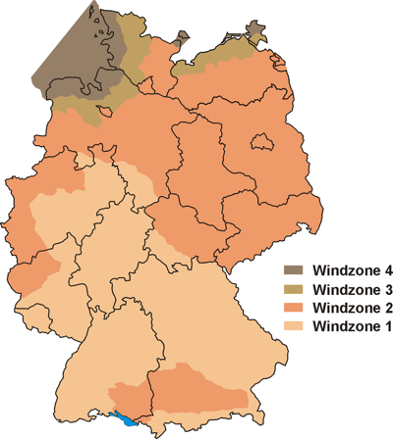Resistance to wind load
Resistance to wind load is the ability of a building element to withstand wind pressure and wind
suction.
Test
The wind stress results from the effect of wind on the building, recorded in the form of wind loads, which consist of wind pressure, wind suction and surcharge values. The wind loads depend, among other things, on the height of the building, the position of the building and the shape of the building.
DIN EN 14351-1 is limited to the verification of deformation. If not sufficiently dimensioned from experience, a structural analysis is required for the main load-bearing elements.
In the wind load test, the building element to be evaluated is mounted in a subframe (steel or wood) and clamped on the test stand. The wind load is applied by static air overpressure or negative pressure. Depending on the tightness of the building element, it may be necessary to seal the resulting gaps by attaching a foil.
Depending on the type of construction element, the deformation of the test sample is included in the result.
Depending on the type of building element, the wind load is tested as part of a combined test, air permeability, water tightness against driving rain and wind load.
The test can also be carried out on external, DAkkS-calibrated test stands on site at the manufacturer.

DIN 1055-4:2005 divides Germany into the wind zones listed below. A tabular list allocated according to administrative boundaries is available at www.dibt.de. However, the official announcements of the federal states are binding.
| Wind zones according to DIN EN 1991-1-4/NA:2010-12 | ||
| Wind zone | Wind speed vref (m/s) | Speed pressure qref (kN/m²) |
| 1 | 22,5 | 0,32 |
| 2 | 25,0 | 0,39 |
| 3 | 27,5 | 0,47 |
| 4 | 30,0 | 0,56 |
Building elements / Standards
The following building components can be tested and classified:
| Building component | Test according to | Classification according to |
| windows – DIN EN 14351-1
external doors – DIN internal doors – DIN |
DIN EN 12211 | DIN EN 12210 |
| facades – DIN EN 13830 | DIN EN 12179 | DIN EN 13116 |
| gates – DIN EN 13241 | DIN EN 12444 | DIN EN 12424 |
| external closures e.g. roller shutters, revolving shutters, sliding shutters –
DIN EN 13659 |
DIN EN 1932 | DIN EN 13659 |
| awnings DIN EN 13561 | DIN EN 1932 | DIN EN 13561 |
Classification
Requirements using the example of windows and doors
| Class according to DIN EN 12210 |
P1 [Pa]a | P2 [Pa]b | P3 [Pa]c |
| 1 | 400 | 200 | 600 |
| 2 | 800 | 400 | 1200 |
| 3 | 1200 | 600 | 1800 |
| 4 | 1600 | 800 | 2400 |
| 5 | 2000 | 1000 | 3000 |
| Exxxxc | — |
a No functional impairments, permanent deformations or damages may occur under this stress
b This pressure is repeated 50 times
c Test samples with stress above class 5, are classified with Exxxx, where -> xxxx is the actual test pressure
| Class according to DIN EN 12210 |
relativ frontal deflections |
| A | <l/150 |
| B | <l/200 |
| C | <l/300 |
Minimum requirements in Germany:
| Requirements | Deformation | Wind load |
| windows
doors |
class B or C | minimum requirements from wind load zone |
| facades | < 15 mm, < l/200 | minimum requirement from wind load zone |
| gates | no permanent damages | external closure At least class 2 |
| Roller, revolving, sliding shutters | – | – |



